Memo Published December 11, 2019 · 12 minute read
Creating an Updraft for Down-Ballot Democrats in 2020
Lanae Erickson & Ryan Pougiales
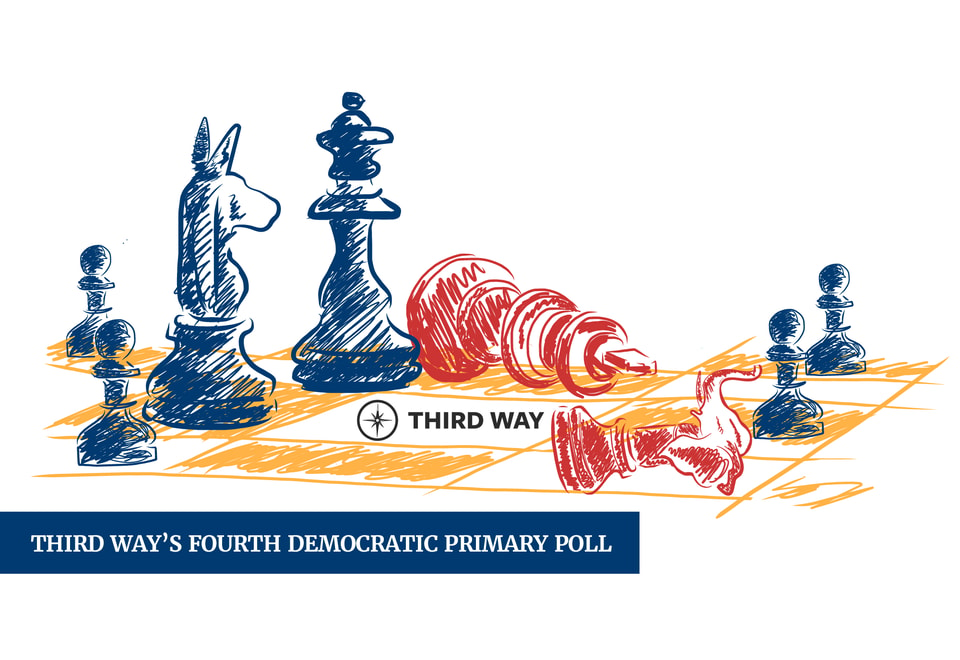
For the past year, Third Way has been working with David Binder Research to conduct quarterly polls of primary voters to better understand what Democrats are looking for in 2020. In our final iteration of 2019, just weeks before voting begins, we find that voters are still sorting out their choice for nominee. But they are settled on one thing: they know they want a candidate who can create an updraft for down-ballot Democrats. While beating Trump is of utmost importance, primary voters aren’t myopic—they care about delivering majorities in the House and Senate and helping state-level candidates as well. And they think that requires rejecting some ideas that draw support from those most active on Twitter, and instead focusing on kitchen-table issues and unifying the country.
- Seventy-four percent of Democratic primary voters believe it is important for the nominee to run on ideas that can help down-ballot Democrats, and 56% say that if they don’t, a nominee can impact other candidates’ ability to win at the federal and state levels.
- Democratic primary voters believe that some ideas popular among the small minority of voters active on Twitter could doom not only the nominee but also down-ballot Democrats. For example, if the nominee called for moving the country toward Democratic Socialism, voters believe it would make it harder for down-ballot Democrats to win by a 49-point margin.
- Instead, they believe the way to win is by focusing on urgent kitchen-table issues that impact the lives of voters and working to unify the country. Voters overwhelmingly say the top issue to focus on for beating Trump is reducing health care costs, and 71% prefer a candidate who can unify the country over fighting for one particular cause.
Finally, while impeachment was not a focus of this research, we did find a substantial increase in House Speaker Nancy Pelosi’s favorability rating compared to our last pre-impeachment poll. Speaker Pelosi’s favorability increased from 63% to 72%, with this increase coming from more respondents with a “strongly favorable” view of her.
The Horserace: Same leader, but changes in momentum, and new entries and exits.
Tracking most national polls, our survey shows that Joe Biden leads the field with the support of 29% of voters. This gives him a two-to-one lead over his nearest competitors, Bernie Sanders at 15% and Elizabeth Warren at 14%. Pete Buttigieg comes in at fourth with 10%. The poll was in the field from November 25 – December 1, 2019.

Candidates’ support by race has been a frequent topic of debate this primary. In our data, among white voters, Biden leads with 25%, while Buttigieg (14%), Warren (14%), and Sanders (13%) are in a dead heat. Biden has support from a near-majority of black voters, at 49%, while Sanders (11%) and Warren (10%) are effectively even. Bloomberg (5%) and Booker (4%) also outperform Buttigieg (2%) with black voters. Biden leads with Latinx voters at 28%, while Sanders is at 20%, and Warren is at 12%. Latinx voters are evenly divided between Bloomberg (8%) and Buttigieg (7%).
Another way of analyzing the state of the primary is by testing how firm voters’ support for their current preference is right now. In an attempt to measure this level of fluidity, we asked respondents to distribute 10 votes across the field of candidates. They could give one candidate all 10 votes, or give 10 candidates each one vote, or anything in between. The results showed that voters’ support remains remarkably fluid. Just 25% gave any candidate all 10 votes, which indicated they were “fully committed.” Biden’s vote is the most entrenched. Nine percent of respondents gave him 10 votes, and another 15% gave him five to nine votes, which meant they were “leaning toward” him. But at the same time, 46% gave Biden zero votes, which signaled they may not be considering him at all.
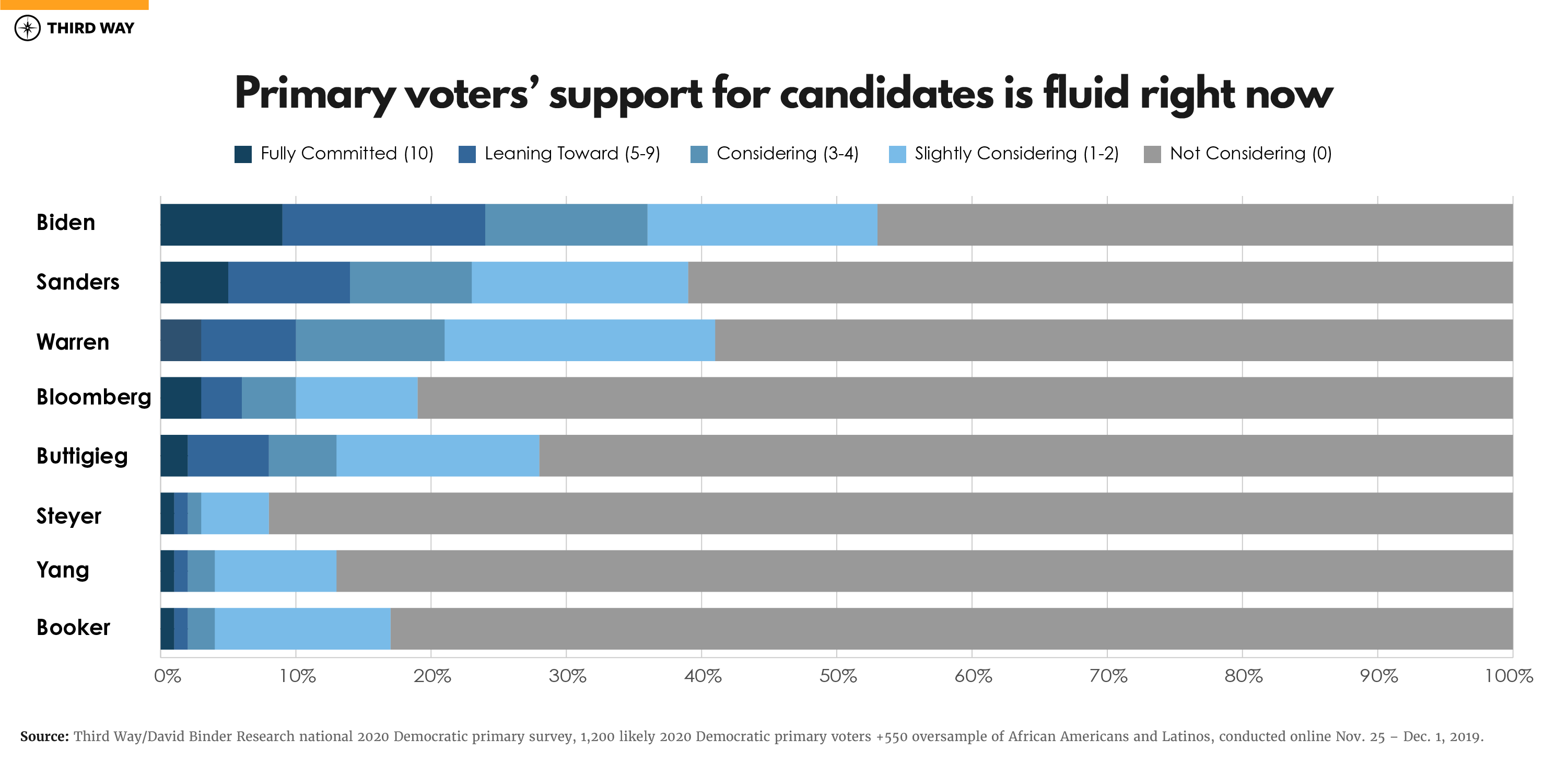
Support in the primary is in flux, but while they aren’t fully committed to their pick, voters are ruling out candidates. Fourteen percent say they will not vote for Biden in the primary, which matches what respondents said in our last poll. Twenty-four percent will not vote for Sanders, which is also consistent with our last survey. The share of voters saying they will not vote for Warren increased from 13% to 18%. The share saying they will not vote for Buttigieg held steady at 14%.
Primary voters want a nominee who can create an updraft for down-ballot candidates.
Democratic primary voters’ top priority for 2020 is to make Donald Trump a one-term president. The necessity of beating Trump is helping motivate people to vote next year, and it is shaping who they are inclined to vote for in the primary as well. But voters also care deeply about electing down-ballot Democrats to other federal offices, in state contests, and in local races. And they believe that the presidential nominee will have a significant impact on those down-ballot Democrats’ chances in 2020.
On a basic level, voters recognize that the presidential nominee at the top of the ticket will affect what happens to down-ballot candidates. Fifty-six percent say that the nominee can help or hurt down-ballot Democrats “a lot” or “some.” Only 24% say that impact will be “just a little” or “not at all.” Older voters are most conscious of this link between the nominee and Democratic candidates’ performance at other levels. Sixty-six percent of those over 65 say that the nominee can help or hurt a lot or some, while this share drops to 48% with those under 35. Among all primary voters, 74% say it is “very important” or “somewhat important” for the nominee to take positions that will help down-ballot Democrats. On this, there is consistency across age cohorts: 80% of those over 65 and 76% of those under 35 agree.

Despite their clear desire to create the best possible circumstances for Democrats to win up and down the ballot, voters are concerned that some candidates in the primary are embracing ideas and narratives that, if taken up by the nominee, will damage down-ballot Democrats’ chances. Many of these ideas first took root on Twitter, and its echo chamber has set up a dangerous distortion that may be confusing campaigns and candidates about the reality of what most Democratic voters actually want. Take the touchstone issue of Medicare for All. The minority of primary voters who are very active on Twitter are 15 points more likely to support Medicare for All than primary voters overall. These Twitter Democrats are 14 points more likely to want a candidate who identifies as a Democratic Socialist. They are also younger, more male, and more likely to live in cities than primary voters overall.
Democratic voters are much more aware than many national pundits seem to be that this social media milieu is not representative of voters in either the primary or the general election. Voters want to make sure their nominee doesn’t get distracted by a small but loud slice of the electorate.
Primary voters say drop the Twitterverse ideas and focus on addressing kitchen-table issues.
All year our polling has tracked the issues that primary voters believe are most important for beating Trump in 2020. They have consistently identified kitchen-table issues as what matters and discounted those ideas that garner the most attention on Twitter. Reducing the cost of health care has led the list in all four of our polls, and in the latest one, the share picking it grew five points to 48%. Addressing climate change, passing gun safety legislation, and lowering taxes on working families while raising them on the rich and corporations have also been consistent priorities. By contrast, earlier in the year, 22% identified Medicare for All as a top issue for beating Trump, but this share fell to 13% in our latest poll. Other Twitter-driven ideas like a federal jobs guarantee were even less popular.

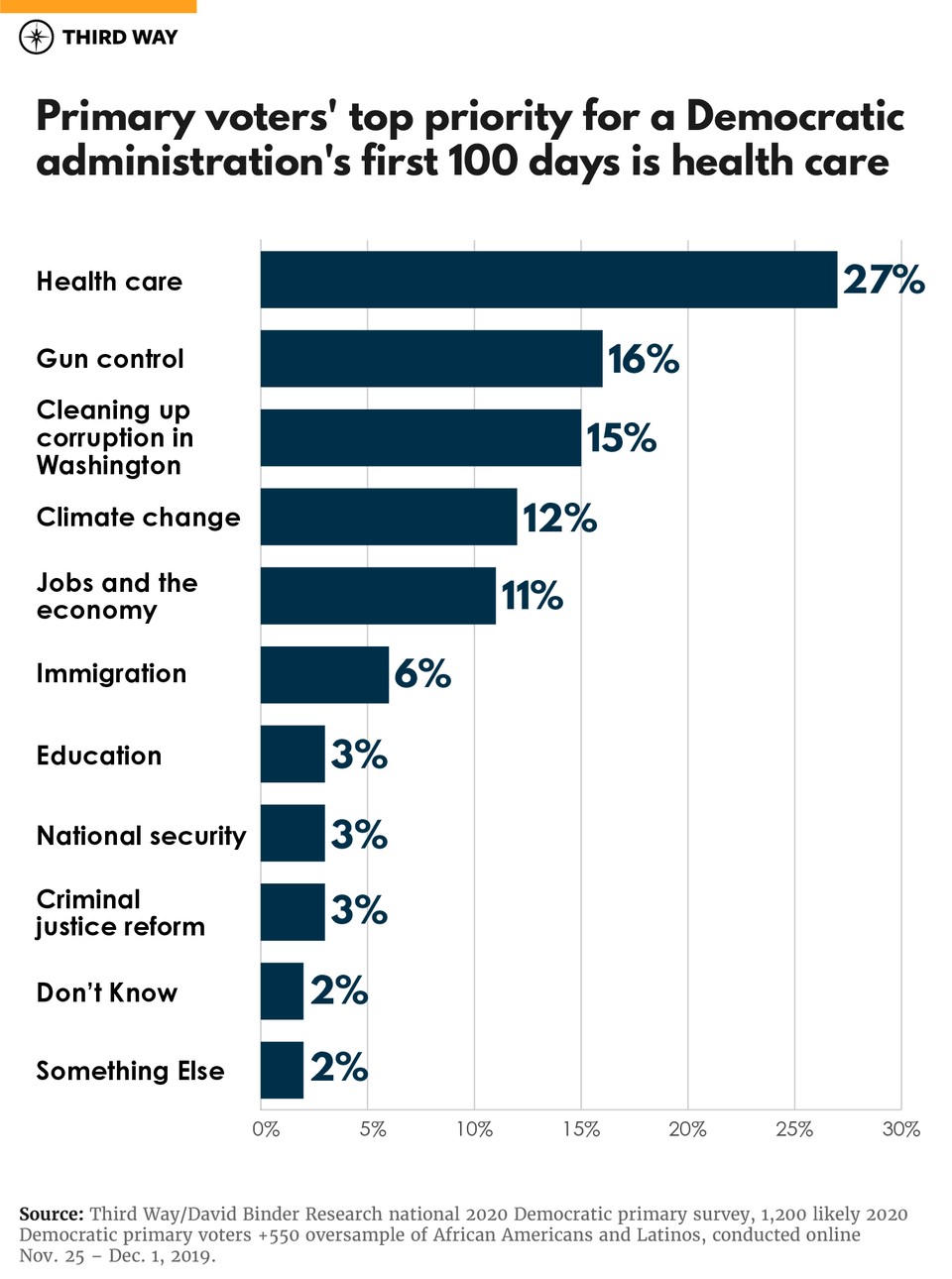
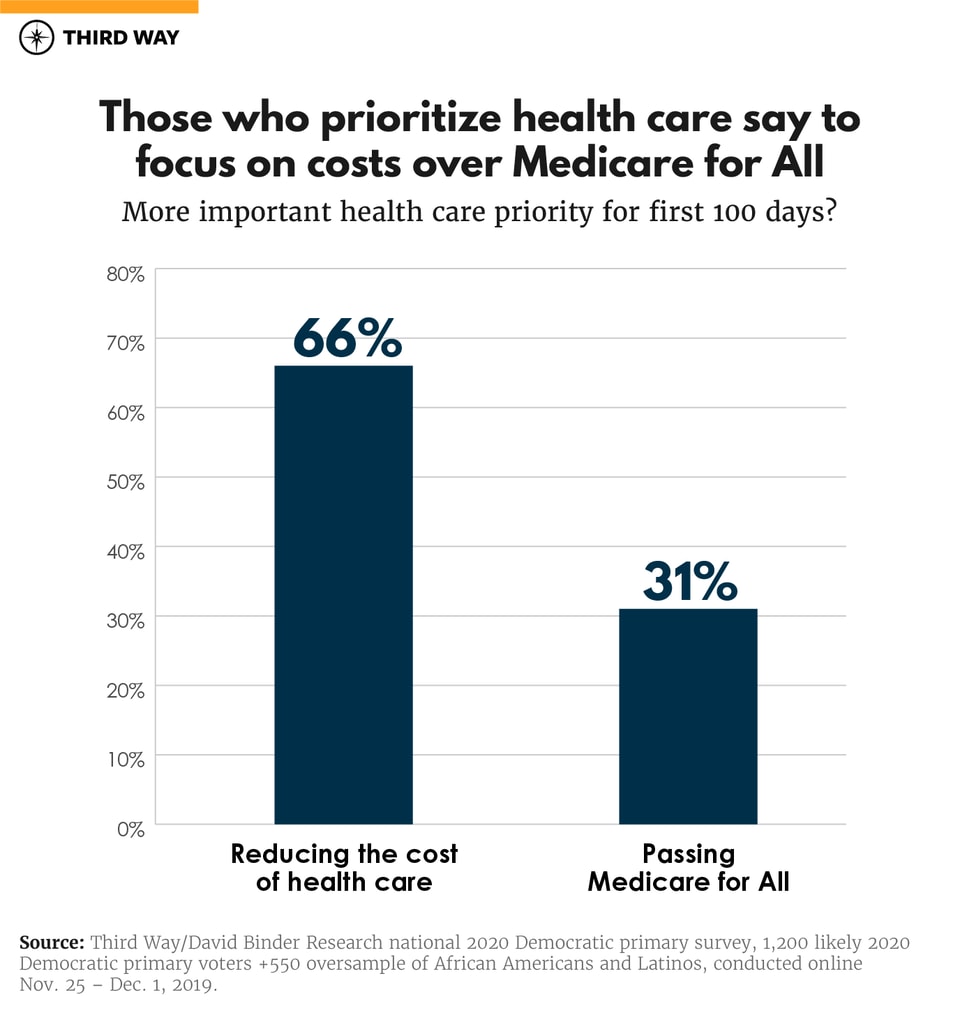
But many ideas popular on Twitter were seen as creating an anchor around the neck of Democratic candidates down-ballot. If the nominee supports moving the country toward Democratic Socialism, for example, primary voters believe it would make it harder for down-ballot Democrats to win by a 49-point margin. While primary voters approve of allowing undocumented immigrants to buy into our health care system, they believe that a nominee focused on giving government health care to all undocumented immigrants would make it harder for down-ballot Democrats to win by a 48-point margin. Large pluralities say that a candidate at the top who embraces Medicare for All and mandatory firearm buybacks would also make it harder for down-ballot Democrats to prevail.
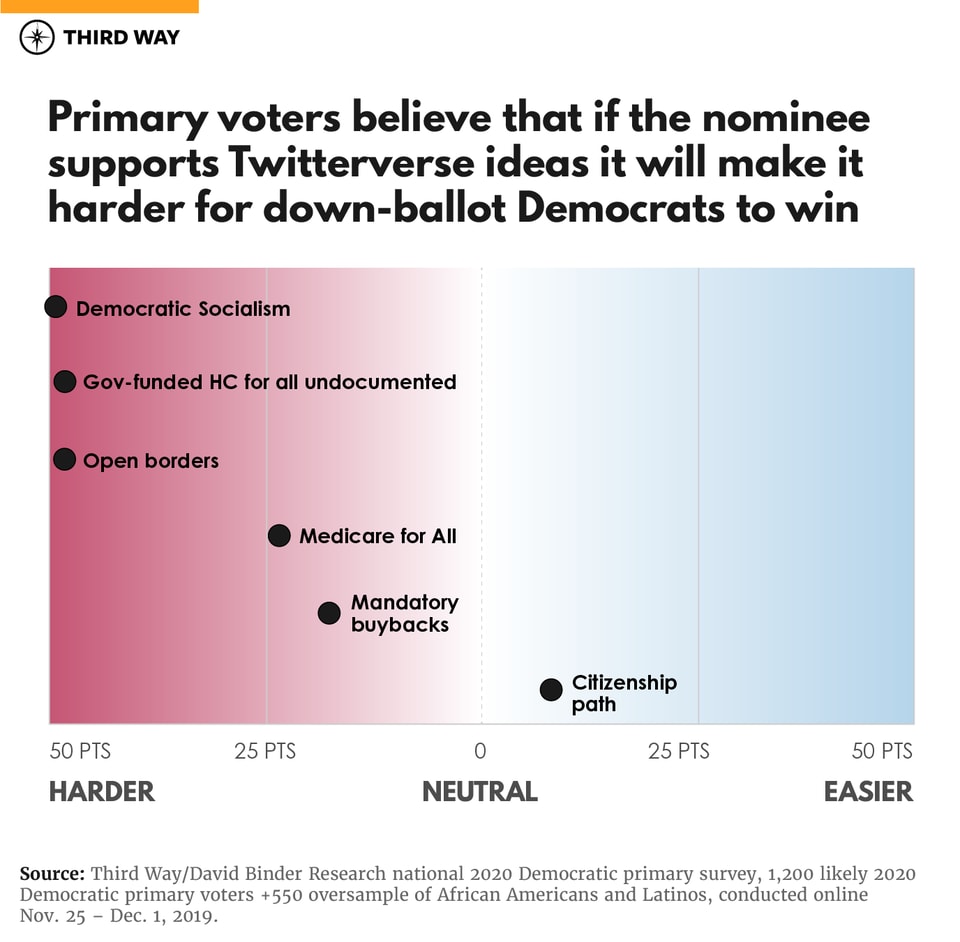
Primary voters want a nominee who can build broad support for Democrats at every level.
All year, we have asked voters a series of questions on the strategic approach they’d like to see from Democratic candidates for president. Consistently, Democratic primary voters have been clear that they want someone who will unify a broad coalition of supporters around an agenda that addresses urgent problems facing voters in their daily lives. This is especially true in the suburbs that will decide the 2020 election.
- By a 71–21% margin, primary voters want a candidate who appeals to a broad range of voters, including some who may have backed Trump, over one who moves left to motivate progressives and liberals. Seventy-four percent of suburban voters prefer a candidate with broad appeal, compared to 67% of urban voters and 69% with small-town/rural voters.
- By a 71–22% margin, primary voters want a candidate who cares more about unifying the country than fighting for a cause. Seventy-two percent of suburban and small-town/rural voters want a unifier, while 68% of urban voters prefer a unifier as well.
- By an 85–10% margin, primary voters want a candidate who offers ideas to address urgent problems over one fixated on shifting the national debate. This overwhelming preference is felt broadly; 85% of suburban and urban voters prefer a focus on urgent problems, and 84% of small-town/rural voters say the same.
- What primary voters don’t want is a Democratic Socialist. By a 56–15% margin, they want a candidate who will mend not end capitalism rather than a Democratic Socialist who will upend the system. Sixty percent of suburban voters want a candidate who will mend capitalism, as well as 49% of urban voters and 57% of small-town/rural voters.
Democratic primary voters believe the way to win in 2020 and lift up down-ballot Democrats is to focus on urgent kitchen-table issues that affect all Americans’ daily lives, and through this agenda, unify a broad coalition that can deliver a decisive victory at every level.
Conclusion
Less than two months out from Iowa, most voters are not fully committed to any one candidate in the primary. But many are starting to consider what they want to see from the nominee come the general election. Top of mind is a candidate who can help create an updraft for down-ballot Democrats. Primary voters warn that if the eventual nominee embraces ideas that draw their popularity from the Twitterverse instead of the electorate, it could do real harm to down-ballot Democrats next year. Instead, they say focusing on kitchen-table issues and a unifying approach is what will beat Trump. At worst, they think the nominee must do no harm to down-ballot candidates. But ideally, primary voters want a candidate at the top of the ticket who can lift up all Democrats at every level across the country, so that the party can take back power from Washington, DC, to their statehouses and local communities.
Methodology
Third Way and David Binder Research partnered to conduct a national survey of likely 2020 Democratic primary voters. The base sample was 1,200 likely 2020 Democratic primary voters, and we also oversampled 250 African American primary voters and 300 Latinx primary voters. This gave a margin of error of 2.8% on the base sample. The survey was conducted online using a panel matched to vote history, in English and Spanish, from November 25th to December 1st, 2019.

